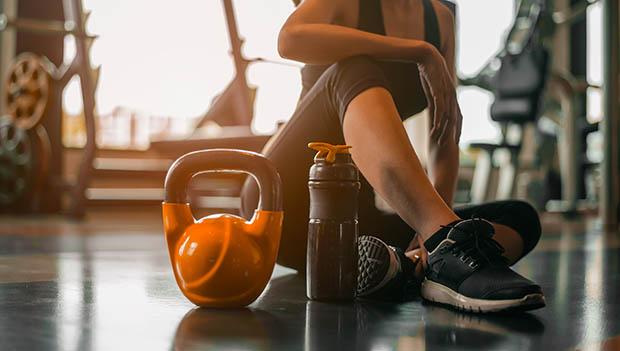
Walk into any sporting goods store, and you'll likely find a wall full of shoes of all shapes and sizes.
It's easy to separate the hiking boots from the soccer cleats, but to the untrained eye, most of the running and athletic shoes look extremely similar.
This can pose a problem for people who love to work out or run, but don't necessarily know what's best for their activity—and oftentimes they pick based on shoe color or fit and feel.
Fit is obviously the most important, but there's a big difference between a running shoe and a shoe designed for functional fitness, including lifting and strength training. And although it might be comfortable, you can be setting yourself up for injury in the long-term or less overall performance.
We're breaking down some of the subtle (and not-so-subtle) differences between strength training shoes and running shoes.
Note that all shoes are built and designed differently, and it's always best to visit your local specialty athletic shoe store for an in-person consultation and fitting.
Flexibility
Running shoes and strength training shoes are flexible in different ways. Since cross training often requires more lateral movement, strength training shoes are built with more flexibility in the midsole for better performance while doing side-to-side exercises. Conversely, running shoes are designed to go one direction: forward. They are often more flexible in the heel-toe transition, but this can vary depending on if you're running in neutral shoes (more flexible) or stability shoes (less so).
Note that flexibility can be a bit tricky to navigate—more flexible shoes often feel better right out of the box but can hinder performance if not appropriate for your activity or biomechanics (and vice versa).
Drop
When lifting weights, it's better to have your feet parallel or almost parallel to the ground. This means strength training shoes have less "drop" than traditional running shoes—drop is essentially defined as the difference in sole thickness under the toes versus under the heel. This is better for squats and other standing weighted exercises.
Running shoes often have a higher drop, which helps promote a smoother heel-toe transition through the running gait, as well as helps protect the runner from the impact of each stride since there's more material under the heel.
Weight
Because strength training shoes require more support and structure to withstand not just the weight of the athlete but the weights they're using for each rep, these shoes are often slightly heavier than running shoes and are built with more durable materials.
Standard running shoes are more lightweight and have soles that help absorb road impact and help keep runners light on their feet for miles on end. Note that picking between a maximal running shoe and minimal shoe also plays a major difference in weight, and each have their own best-use applications (protection versus speed).
Width
Width can be a bit of a toss-up when comparing running shoes to shoes designed for strength or cross-training. Running shoes have been trending wider in recent years—especially trail running shoes. They now often feature wider toe boxes to let toes splay (fancy word for spread out) for better stability. Training shoes are also often wider and not just in the toes. The wider sole helps increase stability and side-to-side support.
Grip
To save weight, running shoe soles are usually only partially covered by grippy rubber. This makes sense, as most runners run on concrete, asphalt or on the track where the ground is inherently grippy already.
Strength training shoes, though, are significantly more grippy as they have to withstand the forces of quick and multi-directional movements—all while on squeaky-clean gym floors. These shoes generally feature soles that have rubber extending to the edge of (if not past) the shoe to maximize traction and prevent slippage.
Support
Similar to the points mentioned regarding flexibly, stability is also a key ingredient in both running and strength training shoes.
Running shoes are most commonly neutral, meaning they have an average amount of support and don't significantly influence how the runner's ankle naturally pronates or supinates. This works for many runners, but for those looking for more support, stability running shoes are made with denser foam toward the inside of the sole to help prevent the ankle from rolling inward (pronating). Over time, picking the right amount of support in a running shoe can be the difference between an injury or a personal best.
They aren't designed for mile after mile of repetitive movements, so strength training shoes are built with a more specific purpose in mind. They often have more support built into the upper to keep the foot in place through side-to-side exercises, and they often have more support in the heel for squats and other weighted exercises.
Looking for training or running shoes? Head over to ACTIVE GearUp for deep discounts on top running, triathlon, fitness and cycling brands.
READ THIS NEXT: Does Running Shoe Type Really Matter?


